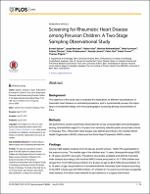Screening for rheumatic heart disease among peruvian children: a two-stage sampling observational study.
Related Resource(s)
https://journals.plos.org/plosone/article?id=10.1371/journal.pone.0133004Date
2015-07Author(s)
Spitzer, Ernest
Mercado, Jorge
Islas, Fabian
Rothenbühler, Martina
Kurmann, Reto
Zürcher, Fabian
Krähenmann, Peter
Llerena, Nassip
Jüni, Peter
Torres, Pedro
Pilgrim, Thomas
Metadata
Show full item recordAbstract
El objetivo de este estudio fue evaluar las implicancias de diferentes clasificaciones de la cardiopatía reumática, sobre la prevalencia estimada y para evaluar sistemáticamente la importancia de los hallazgos incidentales en los exámenes ecocardiográficos en los escolares en Perú. Se realizó una encuesta observacional aleatorizada por grupos con un ecocardiógrafo portable en escolares de 5 a 16 años, de colegios públicos y privados de Arequipa - Perú, seleccionados aleatoriamente. La cardiopatía reumática fue definida de acuerdo al criterio de la Organización Mundial de la Salud y la Federación Mundial del Corazón. La prevalencia de cardiopatía reumática en Perú fue considerablemente menor en comparación con las regiones endémicas de Sub Sahara de Africa, Sub Este de Asia y Oceanía, y paralelamente por un número equivalente de enfermedad coronaria congénita no detectada. Las estrategias para abordar hallazgos colaterales de los exámenes ecocardiográficos deben estar necesariamente en la preparación de los programas de vigilancia de cardiopatía reumática. Background: The objective of the study was to evaluate the implications of different classifications of
rheumatic heart disease on estimated prevalence, and to systematically assess the importance of incidental findings from echocardiographic screening among schoolchildren in
Peru. Methods:
We performed a cluster randomized observational survey using portable echocardiography
among schoolchildren aged 5 to 16 years from randomly selected public and private schools
in Arequipa, Peru. Rheumatic heart disease was defined according to the modified World
Health Organization (WHO) criteria and the World Heart Federation (WHF) criteria. Findings: Among 1395 eligible students from 40 classes and 20 schools, 1023 (73%) participated in
the present survey. The median age of the children was 11 years (interquartile range [IQR]
8–13 years) and 50% were girls. Prevalence of possible, probable and definite rheumatic
heart disease according to the modified WHO criteria amounted to 19.7/1000 children and
ranged from 10.2/1000 among children 5 to 8 years of age to 39.8/1000 among children 13
to 16 years of age; the prevalence of borderline/definite rheumatic heart disease according
to the WHF criteria was 3.9/1000 children. 21 children (2.1%) were found to have congenital
heart disease, 8 of which were referred for percutaneous or surgical intervention.
Conclusions: Prevalence of RHD in Peru was considerably lower compared to endemic regions in subSaharan Africa, southeast Asia, and Oceania; and paralleled by a comparable number of
undetected congenital heart disease. Strategies to address collateral findings from echocardiographic screening are necessary in the setup of active surveillance programs for RHD.
Notes
El Consejo Editorial es un equipo de expertos en el campo de la revista.
Collections
- Artículos científicos [890]






